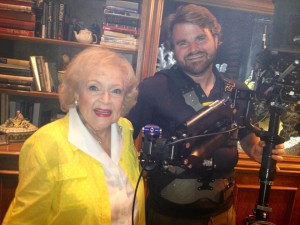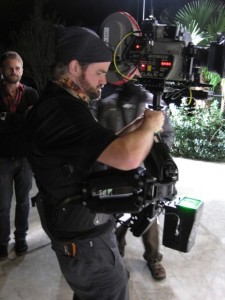Most viewers of the TV drama The West Wing can recall feeling almost out of breath following the cast as they hurtled down hallways, rounded corners, ranged around the enormous set. All thanks to the Steadicam camera operator. Today we have Steadicam operator Will Demeritt talking to us about Steadicam applications. Why does a director choose a camera stabilizing mount rather than a tripod or dolly for the shot?
Demeritt says, “Steadicam is generally best suited for one of two applications: a specialty master or moving coverage.”
Specialty Master

Will Demeritt on set
“The first application, a specialty master, is the sort of iconic shot that filmmakers generally talk about for years and years, affectionately referring to it by the name of the film: the Atonement shot or the Goodfellas shot. For the unaware, the Atonement shot refers to the five-minute long shot at Dunkirk. The Goodfellas shot refers to Ray Liotta and Lorraine Bracco arriving at the Copacabana.
“In this application, a single shot can tell a compelling piece of the story through uninterrupted involvement with the characters. The Atonement shot, for example, keeps us with James McAvoy through his arrival at Dunkirk, and over the five-minute shot we see the disarray, confusion and anxiety of all the soldiers mustering at the beach. If the shot were edited, we might get some ‘relief’ from the tension, distracting us from the stress of the scene and the weight on the main character.
“This specialty master application is particularly effective when the shot demands it, but a dangerous pitfall for some filmmakers is to use the ‘specialty master’ type shot in order to create tension, rather than exploring the tension in the script with the shot.”
Moving Coverage
“The second Steadicam application,” says Demeritt, “the ‘moving coverage’ type of shot, occurs when a scene takes place moving around an office or location where handheld is too distracting and the landscape prevents dolly track. The entirety of the show ER is a great example, since the whole show unfolds around the doctors running around the hospital, taking care of emergency patients. The Steadicam allows the director to get their coverage in a moving wide master, moving closeups on actors, and so on.”
It’s All About Story
“The similar trait between these two common applications,” says Demeritt, “is camera movement telling a story (or a part of the story) that possibly cannot be told any other way. Generally, it’s the task of the camera operator and DP to help the director decide what tool is best for achieving this: dolly, sticks, crane, Steadicam, etc. Ultimately, the director should try using these tools, including Steadicam, to make his film in the way that best services the story.”
Advice for Young Filmmakers
Asked if a young filmmaker with a limited budget can afford to bring on a Steadicam operator, Demeritt answers, “Absolutely! We may operate like we’re machines, and try to act like we’re all business, but we’re still creative souls, filmmakers and storytellers.”
“You may not get Larry McConkey or Scott Sakamoto, but you’ll never know unless you ask. Steadicam operators value the opportunity to bring a practical education to film students whose practical experience is just taking root. We always make sure to remind the students what a good Steadicam operator costs, but we frequently throw numerous discounts to students looking to learn. I find it amazing that so many filmmakers, directors, producers and DPs get so far along in their career without ever having worked with or hiring a Steadicam operator.

Steadicam rig
“Most Steadicam owners own their own gear,” says Demeritt, “much like the best guitarists own their own guitars, painters own their own brushes, sculptors their own mallet and chisel. Owning your own gear makes the difference between responding to a phone call to day play on a TV show that afternoon or the following morning. As a business decision, it makes the most sense. As an artist, the better you know your gear, the less time you spend ‘figuring it out’ and the more time you spend focusing on the shot and the story.”
The Conscience of the DP
“I recently worked with a student film where they asked my input for a dance sequence – should I do the push in and push out shots on Steadicam or dolly. I recommended that the aesthetic of the shot needed the dolly, and they went with dolly. In the words of Eric Fletcher (A-cam/Steadicam on Dexter), we’re the best friend of the editor and the conscience of the DP. If the DP knows a dolly shot is right and Steadicam is probably wrong, it’s our job to back him up. On the other hand, if they need the shot, we’re moments from losing the light and it’s already on Steadicam, shooting something is better than shooting nothing (and the editor will thank you for SOMETHING).”
Demeritt’s recommendation: “Just call up the Steadicam operator and talk to them. If you identify yourself as a film student, they will very likely treat the call as a teaching opportunity rather than a business opportunity. Education and experience still costs something: the student gains experience which makes them more valuable, and the Steadicam operator gives up time and gives access to equipment, so compensation is most likely going to happen in some way.
“However, I recently heard the quote that I think film students need to drill into their psyche: ‘If you think hiring a professional is expensive, wait until you hire an amateur.’
Steadicam’s Origins
“I believe that technically, the first film a Steadicam was used on was (the Woody Guthrie biopic) Bound for Glory in 1976. Though that was filmed first, Rocky was filmed after but released to theaters first, making it the first theatrical film to use Steadicam.
“I believe Garrett Brown began working on the Steadicam around 1974, ultimately introducing it in 1975. As the story goes, he tested the Steadicam on the steps of the Philadelphia library, filming his then girlfriend running up the steps. The test footage is what sold the use of the equipment on Rocky and also inspired the iconic shot of Rocky running up the steps. While they were filming, I think the test footage was then sent to Stanley Kubrick by his producer, who said he discovered a great invention that Stanley would love. Garrett was then brought on to work on The Shining.”
Steadicam Comes Out When Things Get Interesting
“Steadicam applications are all challenging and unique, which is what makes Steadicam exciting. Generally, we’re not asked to do a simple ‘move camera left to right, lock-off’, as that’s easily a dolly shot. Steadicam usually comes out when things get interesting: ‘move camera left to right, follow the lead in profile, but then I want you to overtake her and come around in front of her, close up on her face, and then the killer will appear over her right shoulder. Recompose and hold him out of focus in the background and walk for another 15 feet, because he’s going to bring the gun up and we’ll see the muzzle flash.’
Sure, we refer to the Goodfellas shot or the Atonement shot, but nothing gets a Steadicam operator more excited than when you describe a shot, and we realize other people will call the shot by the title of your project.”
See Will Demeritt’s demo reel and his filmography.
